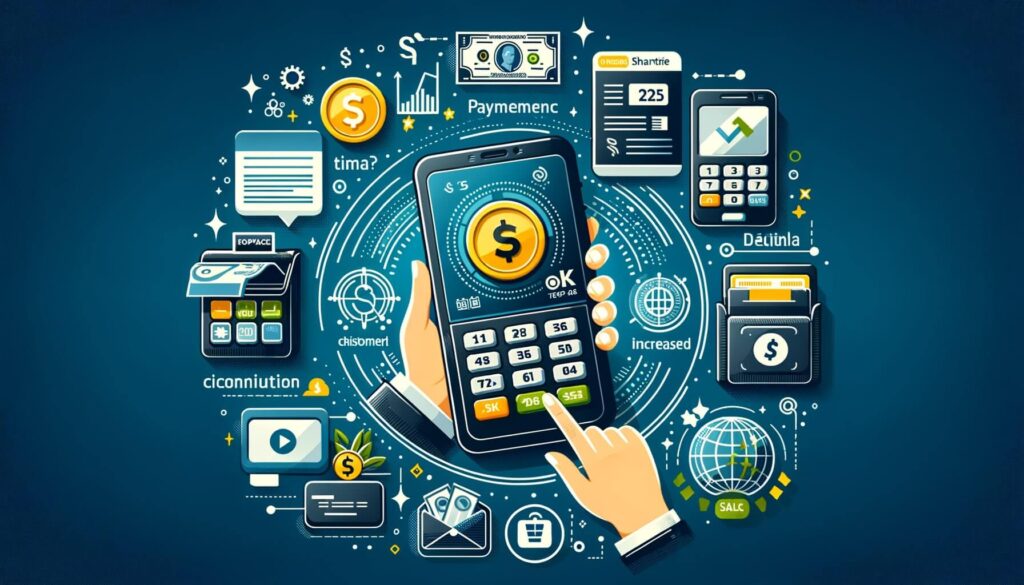
By Carol Peters March 30, 2025
In today’s digital age, mobile payments have become increasingly popular as a convenient and secure way for businesses to accept payments from customers. With the rise of smartphones and mobile apps, consumers are now able to make purchases and complete transactions with just a few taps on their mobile devices. This article will provide a comprehensive guide on how adopting mobile payments can help your business thrive in the modern marketplace.
Mobile payments, also known as m-payments, refer to the use of mobile devices, such as smartphones or tablets, to make payments for goods or services. This technology allows customers to pay for their purchases without the need for physical cash or credit cards. Instead, they can simply use their mobile devices to transfer funds electronically.
The benefits of adopting mobile payments for your business are numerous. Not only does it provide a convenient and seamless payment experience for your customers, but it also offers several advantages for your business operations. By accepting mobile payments, you can streamline your payment processes, reduce transaction costs, and gain valuable insights into customer behavior and preferences.
Benefits of Adopting Mobile Payments for Your Business

1. Increased Convenience: Mobile payments offer a level of convenience that traditional payment methods cannot match. Customers can make purchases anytime, anywhere, without the need to carry cash or credit cards. This convenience factor can attract more customers to your business and encourage repeat purchases.
2. Faster Transactions: Mobile payments enable faster transactions compared to traditional payment methods. With just a few taps on their mobile devices, customers can complete their purchases within seconds. This not only saves time for both customers and businesses but also improves overall efficiency.
3. Reduced Transaction Costs: Accepting mobile payments can help businesses reduce transaction costs. Traditional payment methods, such as credit card processing, often involve high fees and charges. In contrast, mobile payment solutions typically have lower transaction fees, allowing businesses to save money in the long run.
4. Enhanced Security: Mobile payments offer enhanced security features that protect both businesses and customers from fraud and unauthorized transactions. Advanced encryption technologies and tokenization ensure that sensitive payment information is securely transmitted and stored. This can help build trust and confidence among customers, leading to increased sales and customer loyalty.
5. Improved Customer Experience: Mobile payments can significantly enhance the overall customer experience. By providing a seamless and convenient payment option, businesses can create a positive impression and build stronger relationships with their customers. This can lead to increased customer satisfaction, repeat business, and positive word-of-mouth referrals.
How Mobile Payments Can Enhance Customer Experience

Mobile payments have revolutionized the way customers interact with businesses and make purchases. By adopting mobile payment solutions, businesses can enhance the customer experience in several ways.
1. Seamless Integration: Mobile payment solutions can be seamlessly integrated into existing business systems, such as point-of-sale (POS) systems or e-commerce platforms. This allows customers to make payments without any disruptions or additional steps, resulting in a smooth and hassle-free experience.
2. Personalization: Mobile payment solutions often come with built-in customer relationship management (CRM) capabilities. This enables businesses to collect and analyze customer data, such as purchase history and preferences. By leveraging this data, businesses can personalize the customer experience, offering tailored promotions, discounts, or recommendations based on individual customer needs.
3. Loyalty Programs: Mobile payment solutions can be integrated with loyalty programs, allowing businesses to reward customers for their repeat purchases. By offering exclusive discounts, rewards, or points accumulation, businesses can incentivize customers to choose mobile payments and increase customer loyalty.
4. Mobile Wallets: Mobile payment solutions often include mobile wallet functionality, which allows customers to store their payment information securely on their mobile devices. This eliminates the need to enter payment details for each transaction, making the checkout process faster and more convenient.
5. Contactless Payments: Mobile payments support contactless payment methods, such as Near Field Communication (NFC) or Quick Response (QR) codes. This enables customers to make payments by simply tapping their mobile devices or scanning a QR code, eliminating the need for physical contact or the exchange of cash or cards. Contactless payments have gained significant popularity, especially in the wake of the COVID-19 pandemic, as they offer a hygienic and safe payment option.
Choosing the Right Mobile Payment Solution for Your Business

When it comes to choosing the right mobile payment solution for your business, there are several factors to consider. Here are some key considerations to help you make an informed decision:
1. Compatibility: Ensure that the mobile payment solution you choose is compatible with your existing business systems, such as POS systems or e-commerce platforms. Seamless integration is crucial to provide a smooth payment experience for your customers.
2. Security Features: Look for mobile payment solutions that offer robust security features, such as encryption, tokenization, and fraud detection. These features are essential to protect sensitive payment information and build trust among your customers.
3. Payment Options: Consider the payment options supported by the mobile payment solution. Ideally, it should support a wide range of payment methods, including credit cards, debit cards, mobile wallets, and contactless payments. This ensures that you can cater to the diverse preferences of your customers.
4. Scalability: Choose a mobile payment solution that can scale with your business as it grows. This is particularly important if you have plans to expand your operations or enter new markets in the future. The solution should be able to handle increased transaction volumes and support additional features or functionalities.
5. Customer Support: Evaluate the level of customer support provided by the mobile payment solution provider. Prompt and reliable customer support is crucial, especially if you encounter any technical issues or require assistance during the implementation process.
Implementing Mobile Payments: Step-by-Step Guide

Implementing mobile payments for your business requires careful planning and execution. Here is a step-by-step guide to help you navigate the implementation process:
1. Define Your Objectives: Clearly define your objectives for adopting mobile payments. Identify the specific benefits you hope to achieve, such as increased sales, improved customer experience, or reduced transaction costs. This will guide your decision-making process and help you choose the right mobile payment solution.
2. Research Mobile Payment Solutions: Conduct thorough research on different mobile payment solutions available in the market. Consider factors such as compatibility, security features, payment options, scalability, and customer support. Shortlist a few solutions that align with your business requirements.
3. Evaluate Costs and Fees: Assess the costs and fees associated with each mobile payment solution. Consider factors such as transaction fees, setup fees, monthly fees, and any additional charges. Compare the costs against the potential benefits to determine the overall value proposition.
4. Test the Solution: Before fully implementing the mobile payment solution, conduct a pilot test to ensure its compatibility and functionality. Test the solution with a small group of customers or within a controlled environment to identify any potential issues or areas for improvement.
5. Train Your Staff: Provide comprehensive training to your staff on how to use the mobile payment solution. Ensure that they are familiar with the features, functionalities, and troubleshooting procedures. This will help them assist customers and address any queries or concerns effectively.
6. Communicate with Customers: Inform your customers about the availability of mobile payment options and the benefits they offer. Use various communication channels, such as email newsletters, social media, or in-store signage, to raise awareness and encourage adoption.
7. Monitor and Analyze: Continuously monitor and analyze the performance of your mobile payment solution. Track key metrics, such as transaction volumes, customer feedback, and sales data, to assess the impact of mobile payments on your business. Use this data to make informed decisions and optimize your mobile payment strategy.
Ensuring Security and Fraud Prevention in Mobile Payments
Security and fraud prevention are critical considerations when adopting mobile payments for your business. Here are some best practices to ensure the security of your mobile payment transactions:
1. Choose a Secure Mobile Payment Solution: Select a mobile payment solution that offers robust security features, such as end-to-end encryption, tokenization, and two-factor authentication. These features protect sensitive payment information and reduce the risk of unauthorized access or data breaches.
2. Educate Your Staff and Customers: Train your staff on security best practices and educate them about the potential risks associated with mobile payments. Encourage them to follow security protocols, such as not storing customer payment information and regularly updating passwords. Similarly, educate your customers about the importance of secure mobile payment practices, such as using strong passwords and avoiding suspicious links or apps.
3. Implement Strong Authentication Measures: Implement strong authentication measures, such as biometric authentication (e.g., fingerprint or facial recognition) or one-time passwords (OTPs). These measures add an extra layer of security and ensure that only authorized users can access and complete mobile payment transactions.
4. Regularly Update and Patch Systems: Keep your mobile payment systems and devices up to date with the latest security patches and software updates. Regularly check for updates from your mobile payment solution provider and promptly apply them to address any known vulnerabilities or security issues.
5. Monitor and Detect Fraudulent Activities: Implement real-time monitoring and fraud detection systems to identify and prevent fraudulent activities. Set up alerts for suspicious transactions or patterns, such as unusually high transaction amounts or multiple transactions from the same device. Promptly investigate and take appropriate action if any fraudulent activities are detected.
Mobile Payments vs. Traditional Payment Methods: A Comparison
Mobile payments offer several advantages over traditional payment methods. Here is a comparison between mobile payments and traditional payment methods:
1. Convenience: Mobile payments offer unparalleled convenience, allowing customers to make purchases anytime, anywhere, with just a few taps on their mobile devices. In contrast, traditional payment methods, such as cash or credit cards, require physical presence and may involve additional steps, such as entering PINs or signing receipts.
2. Speed: Mobile payments enable faster transactions compared to traditional payment methods. With mobile payments, customers can complete their purchases within seconds, whereas traditional payment methods may involve waiting in line or manual processing, resulting in longer transaction times.
3. Security: Mobile payments offer enhanced security features, such as encryption and tokenization, which protect sensitive payment information. Traditional payment methods, such as cash or credit cards, are more susceptible to theft or loss, and fraudulent activities can be harder to detect.
4. Cost: Mobile payments often have lower transaction fees compared to traditional payment methods, such as credit card processing. This can result in cost savings for businesses, especially for high-volume transactions.
5. Customer Experience: Mobile payments significantly enhance the overall customer experience by providing a seamless and convenient payment option. Traditional payment methods may involve additional steps or inconveniences, such as carrying cash or remembering PINs, which can negatively impact the customer experience.
Overcoming Challenges in Adopting Mobile Payments
While adopting mobile payments can offer numerous benefits, businesses may face certain challenges during the implementation process. Here are some common challenges and strategies to overcome them:
1. Technological Infrastructure: Businesses may need to upgrade their technological infrastructure to support mobile payments. This may involve investing in new hardware, software, or POS systems. Conduct a thorough assessment of your existing infrastructure and consult with technology experts to ensure a smooth transition.
2. Customer Adoption: Encouraging customers to adopt mobile payments can be a challenge, especially if they are accustomed to traditional payment methods. Offer incentives, such as exclusive discounts or rewards, to incentivize customers to try mobile payments. Communicate the benefits of mobile payments and provide clear instructions on how to use them.
3. Security Concerns: Security concerns can be a barrier to adopting mobile payments. Address these concerns by choosing a secure mobile payment solution, educating staff and customers about security best practices, and implementing strong authentication measures. Communicate your commitment to security and privacy to build trust among your customers.
4. Training and Support: Training staff on how to use the mobile payment solution and providing ongoing support can be time-consuming and resource-intensive. Develop comprehensive training materials and provide regular updates to ensure that staff are equipped to assist customers effectively. Establish a dedicated support channel to address any technical issues or concerns promptly.
5. Integration Challenges: Integrating mobile payment solutions with existing business systems, such as POS systems or e-commerce platforms, can be complex. Work closely with your mobile payment solution provider and technology experts to ensure seamless integration. Conduct thorough testing and troubleshooting to identify and resolve any integration challenges.
Frequently Asked Questions about Mobile Payments
Q1. What are mobile payments?
A1. Mobile payments refer to the use of mobile devices, such as smartphones or tablets, to make payments for goods or services. Customers can transfer funds electronically using mobile payment apps or mobile wallets.
Q2. How do mobile payments work?
A2. Mobile payments work by securely transmitting payment information from a customer’s mobile device to a merchant’s payment system. This can be done through various technologies, such as Near Field Communication (NFC), Quick Response (QR) codes, or mobile apps.
Q3. Are mobile payments secure?
A3. Mobile payments offer enhanced security features, such as encryption and tokenization, to protect sensitive payment information. However, it is important for businesses and customers to follow security best practices, such as using strong passwords and keeping devices updated, to ensure the security of mobile payment transactions.
Q4. What are the benefits of adopting mobile payments for businesses?
A4. Adopting mobile payments can offer several benefits for businesses, including increased convenience, faster transactions, reduced transaction costs, enhanced security, improved customer experience, and access to valuable customer data.
Q5. How can businesses encourage customers to adopt mobile payments?
A5. Businesses can encourage customers to adopt mobile payments by offering incentives, such as exclusive discounts or rewards. Communicate the benefits of mobile payments, provide clear instructions on how to use them, and ensure a seamless and convenient payment experience.
Conclusion
In conclusion, adopting mobile payments can provide numerous benefits for businesses, including increased convenience, faster transactions, reduced transaction costs, enhanced security, improved customer experience, and access to valuable customer data.
By choosing the right mobile payment solution, implementing it effectively, and ensuring security and fraud prevention measures, businesses can thrive in the modern marketplace. While there may be challenges in adopting mobile payments, such as technological infrastructure, customer adoption, security concerns, training and support, and integration challenges, these can be overcome with careful planning, education, and support.
Embracing mobile payments is essential for businesses to stay competitive and meet the evolving needs and expectations of customers in the digital age.
